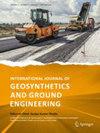Deformative Response of Sheltering Structures Under the Debris Flow Impact
IF 2.3
Q2 ENGINEERING, GEOLOGICAL
International Journal of Geosynthetics and Ground Engineering
Pub Date : 2023-10-24
DOI:10.1007/s40891-023-00488-1
引用次数: 0
Abstract
Abstract A relevant issue in the development of disaster risk reduction strategies is played by design of mitigation measures aimed at reducing risk to acceptable values. For rapid landslides, such as debris flows, sheltering structures are very common mitigation measures realized in exposed areas that allow to protect elements at risk and to stop flowing mass. For the design of these works, the debris flow–structure interaction mechanism is very important. The paper focuses on the evaluation of debris flow–structure interaction mechanism in earth reinforced embankments based on an uncoupled analysis of the interaction in two flow cases (dominant static and dynamic). In particular, a novel approach to evaluate the horizontal stress distribution at different time of the impact phenomenon along the upstream face height of deformable sheltering structures considering the dominant flow component has been proposed. First, impact force over the time against structure is calculated. Subsequently, assuming that debris flow is completely stopped by embankment according to a scheme of accumulation of material behind the obstacle, the deformative response of different geometrical types of embankment is obtained by FEM numerical analysis for considered flow cases. The results of numerical analyses are discussed in terms of horizontal displacements in different control points in sheltering structures. The analysis showed that the deformative response of two geometries of embankments depends on dominant static or dynamic components of impact force.泥石流冲击下掩蔽结构的变形响应
设计旨在将风险降低到可接受值的减灾措施是减灾战略制定中的一个相关问题。对于快速滑坡,如泥石流,在暴露地区建立掩蔽结构是非常常见的缓解措施,可以保护处于危险中的元素并阻止流动的物质。对于这些工程的设计,泥石流-结构的相互作用机理是非常重要的。本文通过对两种流态(静态流态和动态流态)下泥石流-结构相互作用的非耦合分析,对土加筋土路堤泥石流-结构相互作用机理进行了评价。特别是,提出了一种考虑优势流分量的沿可变形掩蔽结构上游面高度冲击现象不同时刻水平应力分布的新方法。首先,计算随时间推移对结构的冲击力。随后,假设泥石流完全被路堤阻挡,采用障碍物后堆积方案,通过有限元数值分析,得到了不同几何类型路堤在考虑流动情况下的变形响应。从不同控制点的水平位移角度对数值分析结果进行了讨论。分析表明,两种几何形状的路堤的变形响应取决于冲击力的主要静力或动力分量。
本文章由计算机程序翻译,如有差异,请以英文原文为准。
求助全文
约1分钟内获得全文
求助全文
来源期刊

International Journal of Geosynthetics and Ground Engineering
ENGINEERING, GEOLOGICAL-
CiteScore
4.20
自引率
17.20%
发文量
68
 求助内容:
求助内容: 应助结果提醒方式:
应助结果提醒方式:


